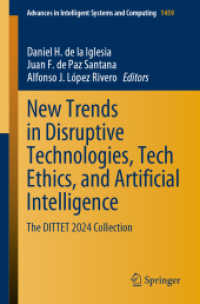Full Description
Comprehensive resource on sustainable chemistry, bridging the skill gap between academic science education and innovation and entrepreneurship
Innovation Management in Sustainable Chemistry links science with business. Written for science and engineering students with an interest in start-ups and business ambitions, it shows how sustainable chemistry can move from the lab into the real world. The book takes a hands-on approach, offering exercises and teaching by example. It gives students a solid base in sustainable chemistry and business principles, combined with real-life case studies, providing both theory and practice.
Written by one of Europe's leading academics, who is also an inventor and entrepreneur, the book starts by teaching the basics of sustainable chemistry, sustainable development, and the circular economy. It then focuses on tools for evaluating sustainable innovation projects and ideas. You will learn about business archetypes and narratives, business models, value creation, and value capture. Team composition, IP strategy, and raising capital are covered next, with guidance drawn from experienced professionals.
The two foundation chapters are followed by seven real-life case studies. These follow the stories of start-ups and scale-ups in environmental sampling, catalysis, biodiesel, CO2 conversion, hydrogen storage, and bio-based polymers. Highlighting both successes and failures, the case studies show how the theory of sustainable chemistry is applied in practice. In each chapter, grey 'tech boxes' expand on technological aspects relevant to the case at hand.
Additional teaching materials, including lecture plans and in-class group exercises, can be downloaded for free from the publisher's website.
Contents
1. Understanding the Principles of Sustainable Chemistry 2. From Sustainable Science to Sustainable Business
3. What's in the Water?
4. Do-It-Yourself Chemical Company
5. CO2 Conversion with Microbes and Electricity
6. Biomass Valorisation to Energy and Fuels
7. Flight of the Phoenix
8. Waking Up the Sleeping Giant
9. Once in a Lifetime








